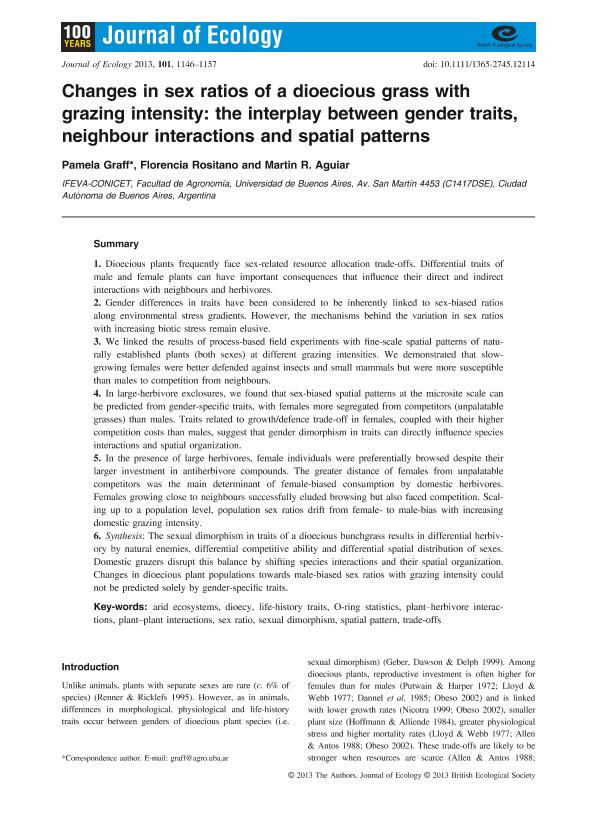Mostrar el registro sencillo del ítem
dc.contributor.author
Graff, Barbara Pamela

dc.contributor.author
Rositano, Florencia

dc.contributor.author
Aguiar, Martin Roberto

dc.date.available
2016-02-16T20:04:22Z
dc.date.issued
2013-09
dc.identifier.citation
Graff, Barbara Pamela; Rositano, Florencia; Aguiar, Martin Roberto; Changes in sex-ratios of a dioecious grass with grazing intensity: the interplay between gender traits, neighbour interactions and spatial patterns; Wiley; Journal of Ecology; 101; 5; 9-2013; 1146-1157
dc.identifier.issn
0022-0477
dc.identifier.uri
http://hdl.handle.net/11336/4220
dc.description.abstract
1. Dioecious plants frequently face sex-related resource allocation trade-offs. Differential traits of male and female plants can have important consequences that influence their direct and indirect interactions with neighbours and herbivores. 2. Gender differences in traits have been considered to be inherently linked to sex-biased ratios along environmental stress gradients. However, the mechanisms behind the variation in sex ratios with increasing biotic stress remain elusive. 3. We linked the results of process-based field experiments with fine-scale spatial patterns of naturally established plants (both sexes) at different grazing intensities. We demonstrated that slowgrowing females were better defended against insects and small mammals but were more susceptible than males to competition from neighbours. 4. In large-herbivore exclosures, we found that sex-biased spatial patterns at the microsite scale can be predicted from gender-specific traits, with females more segregated from competitors (unpalatable grasses) than males. Traits related to growth/defence trade-off in females, coupled with their higher competition costs than males, suggest that gender dimorphism in traits can directly influence species interactions and spatial organization. 5. In the presence of large herbivores, female individuals were preferentially browsed despite their larger investment in antiherbivore compounds. The greater distance of females from unpalatable competitors was the main determinant of female-biased consumption by domestic herbivores. Females growing close to neighbours successfully eluded browsing but also faced competition. Scaling up to a population level, population sex ratios drift from female- to male-bias with increasing domestic grazing intensity. 6. Synthesis: The sexual dimorphism in traits of a dioecious bunchgrass results in differential herbivory by natural enemies, differential competitive ability and differential spatial distribution of sexes. Domestic grazers disrupt this balance by shifting species interactions and their spatial organization. Changes in dioecious plant populations towards male-biased sex ratios with grazing intensity could not be predicted solely by gender-specific traits.
dc.format
application/pdf
dc.language.iso
eng
dc.publisher
Wiley

dc.rights
info:eu-repo/semantics/openAccess
dc.rights.uri
https://creativecommons.org/licenses/by-nc-sa/2.5/ar/
dc.subject
Arid Ecosystems
dc.subject
Dioecy
dc.subject
Life-History Traits
dc.subject
O-Ring Statistics
dc.subject.classification
Ecología

dc.subject.classification
Ciencias Biológicas

dc.subject.classification
CIENCIAS NATURALES Y EXACTAS

dc.title
Changes in sex-ratios of a dioecious grass with grazing intensity: the interplay between gender traits, neighbour interactions and spatial patterns
dc.type
info:eu-repo/semantics/article
dc.type
info:ar-repo/semantics/artículo
dc.type
info:eu-repo/semantics/publishedVersion
dc.date.updated
2016-03-30 10:35:44.97925-03
dc.journal.volume
101
dc.journal.number
5
dc.journal.pagination
1146-1157
dc.journal.pais
Estados Unidos

dc.journal.ciudad
Hoboken
dc.description.fil
Fil: Graff, Barbara Pamela. Consejo Nacional de Investigaciones Científicas y Técnicas. Oficina de Coordinación Administrativa Parque Centenario. Instituto de Investigaciones Fisiológicas y Ecológicas Vinculadas a la Agricultura; Argentina
dc.description.fil
Fil: Rositano, Florencia. Consejo Nacional de Investigaciones Científicas y Técnicas. Oficina de Coordinación Administrativa Parque Centenario. Instituto de Investigaciones Fisiológicas y Ecológicas Vinculadas a la Agricultura; Argentina
dc.description.fil
Fil: Aguiar, Martin Roberto. Consejo Nacional de Investigaciones Científicas y Técnicas. Oficina de Coordinación Administrativa Parque Centenario. Instituto de Investigaciones Fisiológicas y Ecológicas Vinculadas a la Agricultura; Argentina
dc.journal.title
Journal of Ecology

dc.relation.alternativeid
info:eu-repo/semantics/altIdentifier/url/http://onlinelibrary.wiley.com/doi/10.1111/1365-2745.12114/abstract
dc.relation.alternativeid
info:eu-repo/semantics/altIdentifier/doi/http://dx.doi.org/DOI:10.1111/1365-2745.12114
dc.relation.alternativeid
info:eu-repo/semantics/altIdentifier/issn/0022-0477
Archivos asociados
